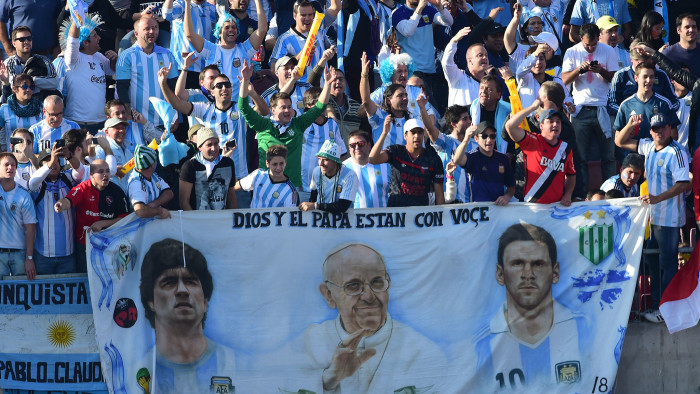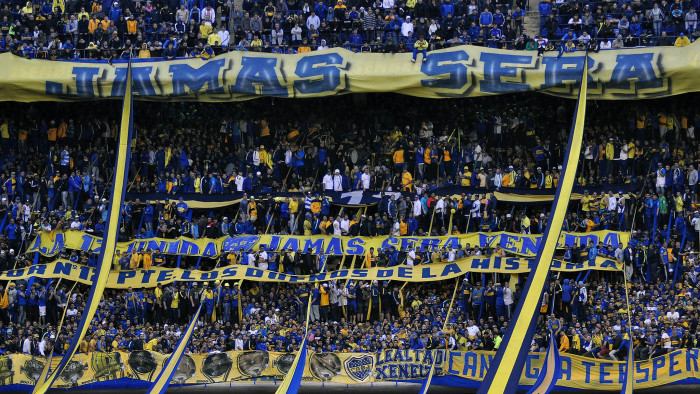Argentine football controversies mirror the country’s politics

Roula Khalaf, Editor of the FT, selects her favourite stories in this weekly newsletter.
It was while covering the Falklands war as the FT’s Buenos Aires correspondent that I first witnessed the singular passion generated by football in Argentina. Fans at the Boca Juniors stadium — Diego Maradona’s home ground — used to jump up and down roaring: “El que no salta es un inglés!” — “If you don’t jump you’re an Englishman!” Nor was the military junta shy to exploit Argentina’s footballing pedigree: one propaganda leaflet depicted a cartoon of a Maradona lookalike accepting the surrender of an imperial British lion.
The junta ended up surrendering to the British military in June 1982, and weeks later Argentina’s national team surrendered the World Cup. A nation’s illusion of invincibility was crumbling but four years later Maradona almost single-handedly returned Argentina to World Cup victory in Mexico.
Football, with its visceral extremes often mirroring political upheavals, exercises a powerful grip on Argentine culture. Even the new president of Argentina, Mauricio Macri, is a former president of Boca Juniors, and the Buenos Aires-born Pope Francis is an unabashed fan of the city’s San Lorenzo side.
Maradona is long retired but the superlatives (a 2000 poll voted him greatest player of all time) have moved on to his countryman, the Barcelona forward Lionel Messi, five times Fifa world player of the year. But both men’s reputations off-pitch have known controversy: the former for his drug-taking; the latter for a conviction in a Spanish court for tax fraud, a charge he denied.
Of the two, Maradona most personifies Argentine popular culture because of his poor, semi-indigenous roots, and the fact that he has lived and played longest in his native country. Messi has lived in Barcelona since he was 13, and his most memorable performances have been for club, not country.
And in a sign of internal squabbles affecting the national sport, Messi recently announced he was quitting international football — only to return just weeks later. The player missed a penalty in Argentina’s defeat by Chile in the Copa América final; then he excluded himself from the 2016 Olympics team.
Maradona, a celebrity still, is consistently unafraid to criticise the management of the Argentine Football Association. He recently accused its former president, and senior Fifa executive, the late Julio Grondona, of having run a Mafia-like organisation.
Maradona’s latest intervention gives him unlikely common cause with the country’s president, who is backing robustly a Fifa investigation into the longstanding unaccountability of Argentine football, calling it “a system of bad habits and corruption”.
In truth Maradona is an unpredictable ally, given his support for Macri’s bitterest adversary, former president Cristina Fernández. Nor does the Maradona lifestyle play to the kind of accountable, trustworthy new Argentina model that Macri aspires to. Nevertheless, Macri is very aware of Maradona’s special status — the triumphant statue of the player inside La Bombonera, the Boca stadium, is one reminder.
Maradona regularly attends La Bombonera, boosting its already feverish atmosphere. Bombonera means chocolate box in Spanish, but there is nothing sweet or contained about the stadium. To this day an enduringly militant section displays its tribal loyalty with an intensity hard to find in any other sports arena in the world.

Nothing can contain the fans occupying the most popularly priced section, called La Doce (No 12), because the level of support here is equivalent to putting an extra player on the pitch. Concrete terraces vibrate as fans pogo up and down; frenzied drumbeating, chants, fireworks and blatant intimidation of visiting players and officials a reminder of Argentina’s social divide and potential for violence.
The stadium may be less of a cauldron than when I first attended, thanks to improved security, a legacy of Macri’s clean-up campaign at the club. There has also been modernisation to boost sponsorship and executive hospitality. But only the most hardened visiting overseas fan will find the atmosphere at La Bombonera, and other stadiums in the capital, so absorbing that he will forget all fear.
Many of the most fanatical supporters in Argentine football organise themselves into rival club gangs — the so-called barras bravas ready to confront rivals or riot police alike.
Macri’s desire to defuse the violence and political influence of the barras bravas continues a campaign embarked upon when he took over at Boca Juniors in 1995. He had mixed results, largely because the power of the gangs had its roots in a failed state outside the club.
Governments and the Argentine Football Association alike had ignored the problem for decades, allowing rival barras bravas to be embedded in organised crime. These violent mini-mafias were involved in money-laundering, drug-dealing and gun crime, often with the complicity of police, politicians and club officials.
The government now has a zero-tolerance policy towards football violence, alongside tougher sentences aimed at “civilising” the national sport. Macri, the former football executive, is seemingly well placed to eradicate the corrupt links between football, business and political interests that flourished under previous military and civilian governments. And he does have the pontiff on his side.
Jimmy Burns is a former Buenos Aires correspondent of the FT. He is the author of ‘The Hand of God’ and ‘Francis: Pope of Good Promise’, biographies of Diego Maradona and Pope Francis, respectively
Comments